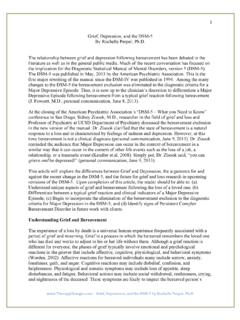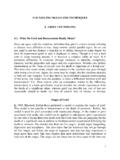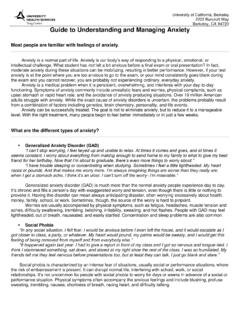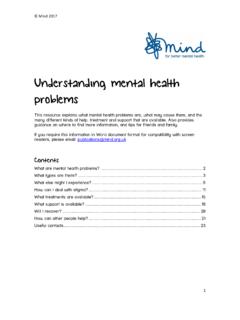Transcription of THERAPY CHANGES GUIDE
1 THERAPY CHANGES GUIDE . Grief, Depression, & The DSM-5. By Rochelle Perper, The relationship between grief and depression following bereavement has been debated in the literature as well as in the general public media. Much of the recent conversation has focused on the implication for the Diagnostic Statistical Manual of Mental Disorders, version 5 (DSM-5). The DSM-5 was published in May, 2013 by the American Psychiatric Association. This is the first major rewriting of the manual since the DSM-IV was published in 1994.
2 Among the many CHANGES to the DSM-5 the bereavement exclusion was eliminated to the diagnostic criteria for a Major Depressive Episode. Thus, it is now up to the clinician's discretion to differentiate a Major Depressive Episode following bereavement from a typical grief reaction following bereavement (J. Fawcett, , personal communication, June 8, 2013). At the closing of the American Psychiatric Association's DSM-5 What you Need to Know conference in San Diego, Sidney Zisook, , researcher in the field of grief and loss and Professor of Psychiatry at UCSD Department of Psychiatry discussed the bereavement exclusion in the new version of the manual.
3 Dr. Zisook clarified that the state of bereavement is a natural response to a loss and is characterized by feelings of sadness and depression. However, at this time bereavement is not a clinical diagnosis (personal communication, June 9, 2013). Dr. Zisook reminded the audience that Major Depression can occur in the context of bereavement in a similar way that it can occur in the context of other life events such as the loss of a job, a relationship, or a traumatic event (Kendler , 2008). Simply put, Dr. Zisook said, you can grieve and be depressed!
4 (personal communication, June 9, 2013). This article will explore the differences between Grief and Depression, the arguments for and against the recent change in the DSM-5, and the future for grief and loss research in upcoming revisions of the DSM-5. Upon completion of this article, the reader should be able to: (a) Understand unique aspects of grief and bereavement following the loss of a loved one;. (b) Differentiate between a typical grief reaction and clinical indicators of a Major Depressive Episode; (c) Begin to incorporate the elimination of the bereavement exclusion to the diagnostic criteria for Major Depression in the DSM-5.
5 And (d) Identify signs of Persistent Complex Bereavement Disorder in future work with clients. understanding Grief & Bereavement The experience of a loss by death is a universal human experience frequently associated with a period of grief and mourning. Grief is a process in which the bereaved remembers the loved one who has died and works to adjust to his or her life without them. Although a grief reaction is different for everyone, the phases of grief typically involve emotional and psychological reactions in the griever that include affective, cognitive, physiological, and behavioral symptoms (Worden, 2002).
6 Affective reactions for bereaved individuals many include sorrow, anxiety, loneliness, guilt, and anger. Cognitive reactions may include disbelief, confusion, and helplessness. Physiological and somatic symptoms may include loss of appetite, sleep disturbances, and fatigue. Behavioral actions may include social withdrawal, restlessness, crying, and nightmares of the deceased. These symptoms are likely to impact the bereaved person's performance both at work or at home. For example, a bereaved individual can experience mental lapses, decreased enthusiasm, difficulty with decision-making, poor concentration, preoccupation and distraction, social withdrawal, and increased interpersonal conflicts.
7 The grief experience is typically recognized by professionals as an entirely normal and expected emotional response to a loss. However, the bereavement literature has yet to show consensus on a distinct course and duration of a typical grief response. The variability that exists in a person's grief is influenced by factors such as the quality of the relationship with the deceased, the bereaved persons'. coping resources, and the nature and context of the loss (Bonanno, et al. 2002). Although there are individual differences, many clinicians agree that a typical course of bereavement might last one to two years, and the bereaved individual will experience intermitted symptoms of grief following a significant loss for the rest of their lives (S.)
8 Zisook, , personal communication, June 9, 2013). Major Depression in Times of Grief Major Depressive Disorder is the classic condition that is characterized by discrete episodes of at least 2 weeks' duration (although most episodes last considerably longer) involving CHANGES in affect, cognition, and neurovegetative functions and may include remissions over time (American Psychiatric Association [APA], 2013). Grief-stricken patients frequently report symptoms that are also typical of major depression, such as intense sadness, tearfulness, and problems sleeping, concentrating, eating and interacting with others.
9 But, as numerous researchers have noted, grief rarely produces the cognitive symptoms of depression such as low self-esteem or feelings of worthlessness (Bonanno, 2001; Bonanno, Wortman, & Nesse, 2004). Although bereaved patients may fantasize about being reunited with a lost loved one through death, they do not generally experience the explicit and persistent suicidal ideation typical of major depression (Friedman, 2012). Other symptoms that suggest Major Depressive Disorder in the context of grief include: (a) Feelings of guilt that are not associated with the loss; (b) Prolonged and marked difficulty in carrying out the activities of day-to-day living, and (c) Hallucinations other than thinking he or she hears the voice or sees the deceased person (Auster, et al.)
10 , 2008). In addition, grief tends to be trigger-related. In other words, the person may feel relatively better while in certain situations, as when friends and family are around to support them. But triggers, like the deceased loved one's birthday, could cause the feelings to resurface more strongly. Major depression, on the other hand, tends to be more pervasive, with the person rarely getting any relief from their symptoms. In addition, unlike those suffering from a Major Depressive Episode, bereaved individuals appear to intuitively understand that time, space, and support is required for healing and adjusting to life (APA, 2013).









